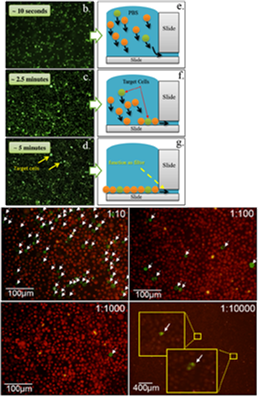Circulating Tumor Cells (CTCs) diagnosis
High-efficiency rare cell identification on a high-density self-assembled cell arrangement chip (BMF 2014)

Detection of individual target cells among a large amount of blood cells is a major challenge in clinical diagnosis and laboratory protocols. Many researches show that two dimensional cells array technology can be incorporated into routine laboratory procedures for continuously and quantitatively measuring the dynamic behaviours of arge number of living cells in parallel, while allowing other manipulations such as staining, rinsing, and even retrieval of targeted cells. In this study, we present a high-density cell self-assembly technology capable of quickly spreading over 300 000 cells to form a dense mono- to triple-layer cell arrangement in 5 min with minimal stacking of cells by the gentle incorporation of gravity and peripheral micro low. With this self-assembled cell arrangement (SACA) chip technology, common fluorescent microscopy and immunofluorescence can be utilized for detecting and analyzing target cells after immuno-staining. Validated by experiments with real human peripheral blood samples, the SACA chip is suitable for detecting rare cells in blood samples with a ratio lower than 1/100 000. The identified cells can be isolated and further cultured in-situ on a chip for follow-on research and analysis. Furthermore, this technology does not require external mechanical devices, such as pump and valves, which simplifies operation and reduces system complexity and cost. The SACA chip offers a high-efficient, economical, yet simple scheme for identification and analysis of rare cells. Therefore, potentially SACA chip may provide a feasible and economical platform for rare cell detection in the clinic.